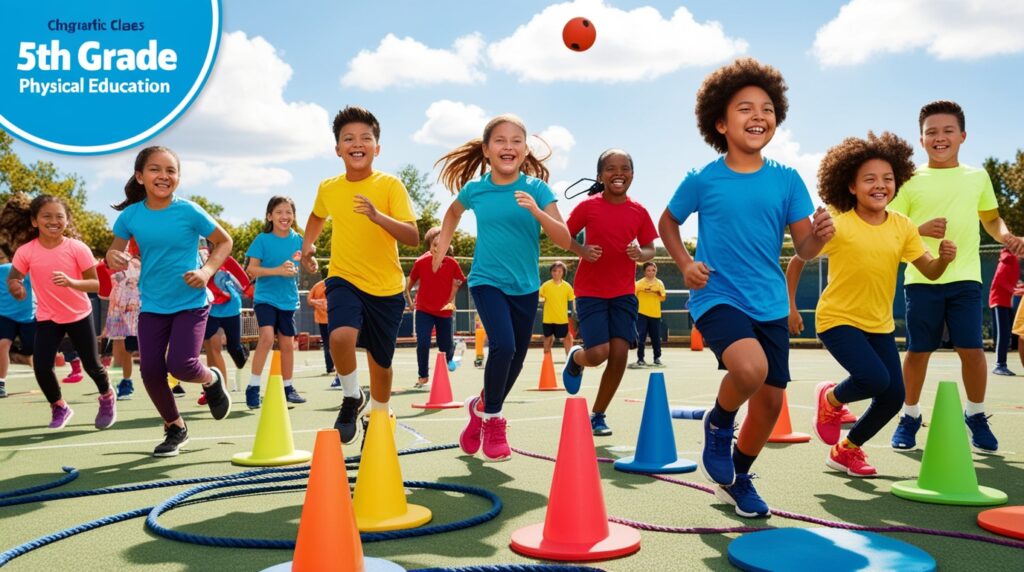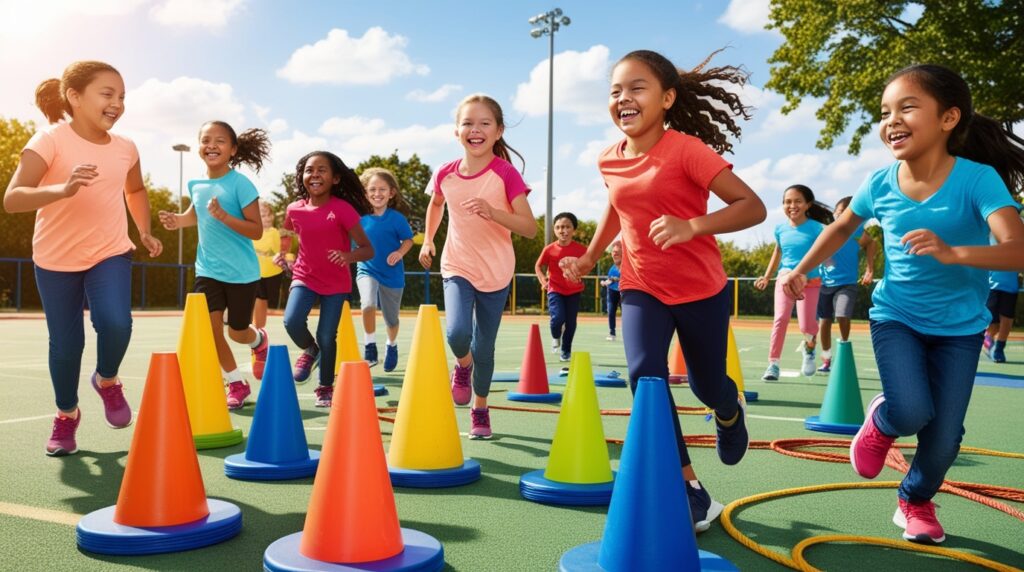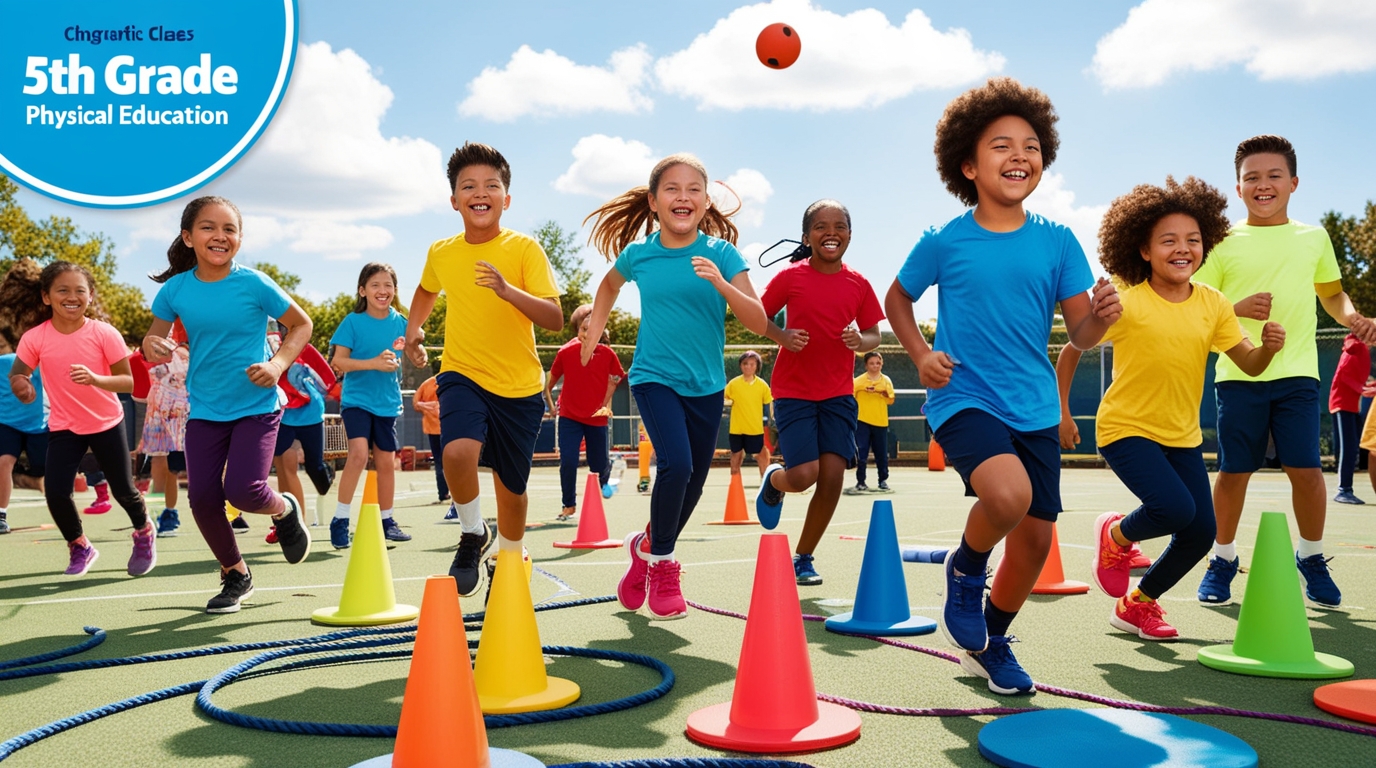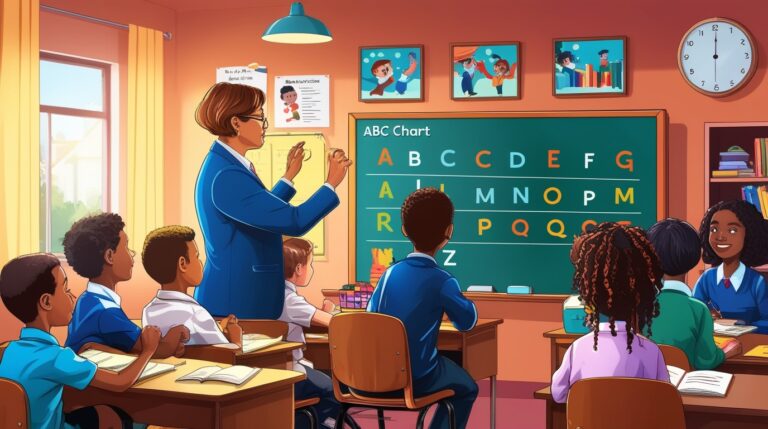Fun Stations for 5th Grade Kids Physical Education
Introduction to PE Fun Stations

Physical Education Fun Stations for 5th Grade Kids Physical Education classes are not just about running laps or doing push-ups—they’re about fostering a lifelong love for movement, teamwork, and healthy living. For 5th graders, PE becomes even more crucial because this is the age when students start understanding competition, coordination, and personal fitness. Fun stations in physical education are a dynamic and engaging way to achieve these goals.
Imagine a PE class where students rotate through different activity zones—each one focusing on a different fitness skill like balance, strength, speed, or flexibility. These “stations” transform a typical class into an adventure playground of movement and excitement. Kids love them because there’s always something new to try, and teachers love them because they keep every child active and engaged.
The concept is simple: divide your gym or outdoor area into several zones, each with a unique challenge or game. Students spend a set amount of time at one station before moving to the next. It’s an interactive, inclusive, and flexible approach that keeps energy levels high while ensuring skill development across multiple domains of fitness.
Why Fun Stations Are Essential in Physical Education
Fun stations are more than just play—they’re structured opportunities for students to develop physical, mental, and social skills. For 5th graders, these stations help bridge the gap between playful movement and structured athleticism. The variety of activities ensures that no student feels left out and that every child can excel in something they enjoy.
One of the biggest benefits of fun stations is differentiation. Not every student learns or moves at the same pace. Stations allow teachers to adapt tasks to meet varying skill levels, giving each child a chance to succeed. Additionally, station-based learning promotes self-directed movement. Students learn to take responsibility for their own performance while respecting time limits and transitions.
Moreover, PE stations create a positive learning environment. Students aren’t competing all the time—they’re exploring, experimenting, and enjoying physical activity. This encourages intrinsic motivation, which is essential for building a lasting appreciation for fitness. Whether it’s jumping, tossing, balancing, or sprinting, every station becomes an opportunity to learn through movement, laughter, and teamwork.
Benefits of Station-Based Activities for 5th Graders
There are countless benefits to using fun stations in a 5th-grade PE program. Physically, they help children build endurance, flexibility, balance, and coordination. Socially, they encourage communication, teamwork, and respect. Emotionally, they foster confidence and self-efficacy as students realize they can master new skills through practice.
From a teacher’s perspective, station activities make class management easier. Because students are distributed across several areas, it reduces crowding and allows for more focused interaction. It also helps in assessment—teachers can observe smaller groups at a time, providing feedback or noting improvements.
Fun stations also make cross-curricular connections possible. For example, a math-inspired station can involve counting repetitions or measuring distances, while a language-themed station can encourage communication through teamwork challenges. This makes learning holistic and meaningful.
In a nutshell, station-based PE classes strike the perfect balance between fun and fitness. They engage the mind, challenge the body, and bring joy to movement—exactly what a 5th-grade PE class should be about.
Planning an Effective PE Station Setup
Before you roll out your cones and jump ropes, proper planning is key. The success of fun stations lies in thoughtful organization. The first step is understanding your learning objectives. Are you focusing on cardiovascular fitness, coordination, teamwork, or flexibility? Once your goals are clear, design stations that align with them.
Another crucial step is choosing age-appropriate activities. Fifth graders are at a developmental stage where they enjoy challenges but still need safety and simplicity. Avoid overly competitive or high-intensity activities that may cause frustration. Instead, create stations that balance skill-building with fun.
Space management is another vital aspect. Arrange stations in a way that allows smooth transitions without collisions or confusion. Use clear signage, visual markers, or color-coded equipment to make navigation easy. Also, have a rotation plan—whether it’s based on time intervals or whistle signals—to maintain order and rhythm throughout the session.
Lastly, always conduct a safety check before class. Make sure equipment is secure, the ground is clear, and each station is well-defined. Remember, a well-planned setup not only ensures a smooth class flow but also maximizes learning outcomes and enjoyment for students.
Understanding the Goals of the Lesson

Every PE class should start with a clear purpose. Are you aiming to build endurance, enhance coordination, or improve teamwork? Having a focused objective helps you choose the right combination of stations. For instance, if the goal is to build aerobic capacity, include activities like jump rope, shuttle runs, or hula hoop challenges. If it’s about improving balance and focus, try stations like yoga poses or balance beam challenges.
Establishing these goals also helps in assessment. Teachers can easily measure progress by observing how students perform specific tasks. For example, if the objective is agility, record how many cones a student can weave through in 30 seconds. This data-driven approach allows for measurable improvement tracking and individualized feedback.
Moreover, sharing the goals with students creates ownership of learning. When kids know why they’re doing something, they engage more deeply. Begin each class by explaining the purpose of each station and how it connects to their overall fitness journey. This transparency turns every activity into a stepping stone toward a broader learning objective—making PE not just fun, but meaningful.
Choosing Age-Appropriate Activities
When designing fun stations for 5th graders, selecting age-appropriate activities is essential. At this stage, kids are developing stronger coordination, balance, and strength, but they still crave creativity and fun. Your goal as an instructor is to blend skill-building with excitement—so children don’t just see PE as exercise, but as an adventure.
Choose activities that are challenging but not overwhelming. For example, instead of setting up a traditional push-up station, make it fun with an “animal movement” challenge—where students crawl like bears or hop like frogs. This keeps the energy high while improving muscular strength. Another option is a “jump challenge,” where students compete to see how many jumping jacks or rope jumps they can complete in 30 seconds.
Safety should always come first. Avoid activities that could result in collisions or require complex equipment handling. Fifth graders enjoy competition, but they’re still learning emotional regulation—so cooperative activities (like partner challenges or team races) promote teamwork and positive sportsmanship.
The best way to ensure engagement is through variety. Include stations that target different components of fitness—strength, speed, endurance, flexibility, and coordination. This diversity keeps the session dynamic and ensures every child finds an activity they enjoy. When fun meets fitness, PE becomes the highlight of the school day.
Setting Up Equipment and Space Efficiently
The key to a successful PE station setup lies in organization and flow. Whether you’re working in a gymnasium, playground, or open field, your space should be divided in a way that encourages smooth movement between stations. Each area should have clearly defined boundaries using cones, ropes, or floor tape. This prevents crowding and ensures safety.
To save time, pre-set equipment before students arrive. For instance, if one station requires jump ropes and another needs bean bags, lay them out neatly in advance. Have a designated “equipment helper” or two students who assist with setup and cleanup—this gives them responsibility while fostering teamwork.
Keep transitions short and structured. You can use music cues or whistle signals to indicate when it’s time to switch stations. For example, play 30 seconds of upbeat music between rotations to make transitions fun rather than chaotic. This simple trick can dramatically improve class management and engagement.
Lastly, always have a backup plan. Equipment can break, or weather can change if you’re outdoors. Having alternative exercises that require little or no equipment ensures your class runs smoothly no matter what. An efficient layout and organized setup not only save time but also enhance student experience—allowing them to focus on movement, not confusion.
Best Fun Station Ideas for 5th Grade PE Classes
Now that we’ve covered planning and setup, let’s explore the heart of the lesson: the fun stations themselves. Below are some of the most engaging, skill-enhancing, and student-approved PE station ideas for 5th graders. Each one focuses on a different fitness component, ensuring a balanced and exciting workout.
1. Obstacle Course Challenge
Nothing excites 5th graders more than a good obstacle course. This station is a playground for agility, coordination, and endurance. You can design it with cones, hurdles, mats, or hoops—anything that encourages kids to crawl, jump, or weave through paths.
How to Set It Up:
Create a pathway that includes jumping over cones, crawling under ropes, zig-zagging around markers, and sprinting to the finish line. Use stopwatches to time each student, so they can try to beat their personal best.
Skills Developed:
- Agility and coordination
- Speed and spatial awareness
- Cardiovascular endurance
To make it even more fun, give it a theme—like “Jungle Escape” or “Mission Impossible.” Students can pretend to be explorers or secret agents navigating their way to safety. This imaginative twist keeps motivation high and transforms fitness into storytelling through movement.
Building Agility and Coordination
Agility and coordination are key physical skills for 5th graders. These qualities not only help in sports but also improve body awareness and reaction time. The obstacle course station is perfect for enhancing these abilities because it challenges kids to move quickly and efficiently while maintaining control.
For agility, incorporate quick lateral movements like side shuffles or ladder drills. For coordination, add activities that require hand-foot synchronization—such as tossing a ball while balancing on one foot. The constant changes in direction and motion help develop neural pathways that support athletic performance.
A great tip is to encourage students to self-reflect after each round. Ask them questions like: “Which part was the hardest?” or “How did you keep your balance?” This not only builds mindfulness in movement but also helps them understand how practice improves skill. Over time, you’ll see faster reaction times, smoother transitions, and a noticeable boost in confidence.
2. Jump Rope Station
Jump rope is a timeless classic that never fails to energize a PE class. It’s simple, requires minimal equipment, and delivers a fantastic cardiovascular workout. Plus, it’s a great way to teach rhythm, timing, and coordination.
How to Set It Up:
Provide each student with a jump rope. Start with basic jumps, then progress to challenges like double-unders or crisscross jumps. For variety, turn it into a jump rope circuit—students can jump for 30 seconds, rest for 10 seconds, then switch styles.
Skills Developed:
- Endurance and stamina
- Balance and rhythm
- Lower body strength
To keep things interesting, host mini competitions or create group routines. Students can work in pairs to choreograph a “jump rope dance” to music, combining creativity with physical fitness. This station not only builds cardiovascular health but also gives students an outlet for expression and teamwork.
Improving Cardiovascular Endurance
Cardiovascular endurance is vital for overall health, and jump rope exercises are among the best ways to improve it. For 5th graders, whose energy levels are naturally high, this station provides an excellent outlet for their enthusiasm.
Start with shorter intervals and gradually increase the duration as endurance builds. Use fun challenges like “Jump for the Beat,” where students try to keep pace with a song’s rhythm. You can also track progress over several weeks by counting how many continuous jumps students can perform without stopping.
Encourage pacing and proper form—remind students to land softly on the balls of their feet and keep their knees slightly bent. This minimizes impact and reduces fatigue. As students build stamina, you’ll notice improvements not only in jump rope skills but also in other sports and activities.
The key to success? Keep it fun, encouraging, and full of movement. The more kids laugh, jump, and move to the rhythm, the more they’ll love PE.
3. Bean Bag Toss
If you want to incorporate coordination and focus, the bean bag toss station is a must-have. It’s simple, safe, and can be adapted for both indoor and outdoor settings. Kids love it because it feels like a game, but in reality, it sharpens their hand-eye coordination and precision.
How to Set It Up:
Place buckets, hoops, or targets at different distances. Give each student a few bean bags and let them toss from a marked line. Vary the distances to challenge skill levels, and assign points to targets for friendly competition.
Skills Developed:
- Hand-eye coordination
- Concentration and accuracy
- Team collaboration
For added excitement, you can introduce themed challenges like “Pirate Treasure Toss” or “Alien Target Practice.” These creative twists keep kids invested and eager to play. By tracking scores, students can also see measurable improvement in accuracy over time.
Enhancing Hand-Eye Coordination
The bean bag toss station is not just fun—it’s a powerful way to enhance a child’s motor skills and hand-eye coordination. When students aim, throw, and adjust their technique, they’re engaging both their brains and bodies in perfect sync. This station can also help students who may struggle with catching or throwing in traditional sports by offering a low-pressure environment to build confidence.
To make the most of this station, vary the difficulty levels. Start with close-range tosses and gradually increase the distance. Use color-coded targets for different points—this adds a competitive yet encouraging element. Teachers can also introduce cooperative play, where teams must reach a combined score to “win” a round. This approach fosters teamwork and communication while ensuring everyone participates.
You can also introduce math connections here. For example, after each round, have students add their total scores or calculate averages. It’s a sneaky way to blend academic learning with physical activity, reinforcing the concept of “learning through play.”
Ultimately, the bean bag toss helps students develop focus, precision, and perseverance—all while having a blast.
4. Balance Beam Fun
Balance is one of the most underrated physical skills, yet it’s essential for nearly every sport and daily movement. The balance beam station helps 5th graders improve stability, coordination, and concentration. You don’t need a professional beam—a sturdy piece of tape on the floor or a low wooden plank can do wonders.
How to Set It Up:
Mark a “beam” path on the floor using gym tape or use actual balance beams if available. Students must walk across without stepping off, and you can add challenges like balancing an object on their heads or holding a ball while walking.
Skills Developed:
- Core strength
- Body awareness
- Concentration and focus
To make it more engaging, turn it into a themed activity such as “Walk the Plank” where kids pretend they’re pirates avoiding the ocean, or “Tightrope Circus Challenge” where they act like performers balancing over a crowd. You can also add variations like walking backward, side-stepping, or hopping for advanced students.
This station not only strengthens physical balance but also builds mental focus and patience. When children slow down and concentrate on staying centered, they learn the importance of control—an invaluable lesson that carries over to other areas of life and sports.
Promoting Core Stability and Focus
Balance activities are perfect for developing core strength, which supports posture, movement, and injury prevention. For 5th graders, this development stage is crucial—they’re growing quickly and learning to control their bodies better. Exercises that challenge stability, like balance beam walks, help strengthen their abdominal and back muscles naturally.
Encourage students to focus on their breathing and posture as they move. Explain that balance isn’t just about muscles—it’s about mind-body connection. When they focus their eyes on a fixed point or calm their breathing, their steadiness improves. These are powerful self-regulation skills that benefit them far beyond PE class.
Teachers can also gamify the experience. For instance, award “balance badges” to students who complete the beam without stepping off or who improve their performance over several weeks. This kind of positive reinforcement keeps motivation high while promoting persistence and mindfulness.
5. Relay Race Corner
Few activities get students more excited than a relay race. It’s fast, dynamic, and full of team spirit. This station is ideal for teaching cooperation, speed, and communication. Plus, it channels kids’ natural competitiveness in a positive, structured way.
How to Set It Up:
Divide the class into equal teams. Set up cones or markers to create lanes for running, skipping, or even crawling relays. Hand off a baton, bean bag, or soft ball to keep the transitions fun.
Skills Developed:
- Speed and agility
- Teamwork and communication
- Sportsmanship and coordination
Make the races creative! Try a “Silly Relay” where students must perform goofy actions like hopping on one leg, or a “Fitness Relay” where each teammate performs a quick exercise before passing the baton (e.g., 5 jumping jacks, 3 squats, etc.).
Relays encourage students to work together, cheer for their teammates, and celebrate every effort—not just victory. This inclusive spirit fosters empathy and camaraderie, reminding students that teamwork always beats individual glory in the long run.
Encouraging Teamwork and Speed
Relay stations are perfect for teaching 5th graders how to balance competition with cooperation. The beauty of a relay race is that it requires every participant to contribute equally to the team’s success. Each student’s effort directly affects the outcome, which builds accountability and mutual respect.
To make things more educational, vary the relay types. Include speed relays for agility, strategy relays (like puzzle piece runs), and fitness relays for endurance. For example, in a “puzzle relay,” each team must run to a table, grab one piece of a puzzle, and assemble it together at the finish line. It’s both mentally and physically stimulating.
Teachers can also use relays to discuss the importance of fair play and encouragement. After each round, hold a brief reflection: How did it feel to win or lose? Did everyone support one another? This kind of debriefing strengthens emotional intelligence, which is just as vital as physical development.
The relay race corner is not only about speed—it’s about team spirit, respect, and perseverance. Every student learns that effort, attitude, and teamwork are what make real champions.
Creative Additions to Make Stations More Exciting
After a few weeks, even the most exciting activities can feel routine. That’s why creativity is key in maintaining engagement in 5th-grade PE. Themed days, music, and rewards can transform regular exercises into thrilling adventures that kids look forward to.
Let’s explore a few creative ways to keep your PE stations fresh, fun, and full of laughter.
Themed PE Days (Pirates, Space, or Jungle Adventures)
Themed days are an absolute game-changer. They transform your PE class into a story-based adventure, making fitness feel like play. Kids can pretend they’re pirates crossing the “shark-infested sea” (balance beams), astronauts hopping across moon rocks (hurdle jumps), or explorers racing through a jungle (obstacle courses).
These themes don’t just add fun—they enhance imagination, engagement, and emotional connection. You can even integrate learning from other subjects. For example:
- Science theme: “Planet PE” with gravity challenges and “asteroid tosses.”
- History theme: “Ancient Olympics” where students reenact events from Greece.
- Math theme: Number-based exercises where each jump equals a math problem solution.
By weaving stories into activities, you’re not just exercising bodies—you’re stimulating young minds. Themed PE classes are memorable, inclusive, and deeply engaging for all types of learners.
Incorporating Music and Rhythm
Music brings energy, structure, and joy to PE. Adding rhythmic elements turns regular movement into dance-like fun. At each station, play upbeat tracks that match the tempo of the activity—for instance, fast-paced songs for relays and steady beats for balance exercises.
You can even create “Rhythm Stations,” where students perform moves to the beat—like clap patterns, jump sequences, or short choreographies. Music also aids in timing and synchronization, helping children understand tempo and coordination naturally.
To make it more interactive, let students choose songs or vote on “Workout of the Week” playlists. This small sense of ownership increases motivation and class participation. Remember, when music and movement combine, PE feels more like a celebration than a lesson.
Using Reward Systems to Motivate Students
Rewards are one of the simplest and most effective ways to keep 5th graders motivated and engaged during PE. When students know their efforts are recognized, they naturally put in more enthusiasm and energy. However, it’s important to emphasize effort and improvement, not just performance. Every student should feel that success is within reach.
You can create a “PE Star Chart” where students earn stickers or points for showing good sportsmanship, teamwork, and effort at each station. At the end of the week, recognize top participants with certificates, “Fitness Hero” badges, or fun titles like “Balance Master” or “Relay Rockstar.”
Another option is to incorporate group rewards. For example, if every team successfully completes all stations with positive attitudes, the class earns a “Free Play Friday” or “Music Day.” This builds collective motivation and fosters a sense of community.
Make sure your rewards are intrinsic-focused, too. Praise effort with words—highlight persistence, cooperation, and kindness. Simple acknowledgments like, “I love how you encouraged your teammate!” or “You really improved your form!” go a long way in building confidence.
Ultimately, reward systems should reinforce positive behavior and help students associate physical activity with joy and self-improvement, not pressure or comparison.
Safety Guidelines and Classroom Management Tips
No matter how fun or creative your PE stations are, safety must always come first. Fifth graders are energetic and sometimes unpredictable, so establishing clear safety guidelines is crucial for a smooth and injury-free class. Good management ensures that all students can move confidently and responsibly.
Start every session by demonstrating the correct way to use equipment and perform activities. Have students repeat or explain the rules back to you—this ensures understanding. Always emphasize the “Three Golden Rules”:
- Respect the space.
- Respect the equipment.
- Respect each other.
Use visual markers such as cones, ropes, or color-coded zones to maintain boundaries. For example, red zones might indicate “waiting areas,” while green zones mean “active play.” This helps prevent overcrowding and confusion during rotations.
During activities, keep moving and observing. Circulate between stations, offering guidance and ensuring all equipment is being used properly. Avoid long explanations—kids lose focus quickly. Instead, use quick cues like, “Freeze!” or “Switch!” to manage transitions efficiently.
Lastly, always have a first-aid kit nearby, and ensure students know what to do if someone gets hurt. By setting expectations early and modeling safety habits, you create a structured environment where students feel secure, respected, and ready to have fun.
Ensuring Proper Supervision
Supervision in a PE class is about more than just watching—it’s about engaging with students while ensuring their safety. When kids rotate through multiple stations, the teacher must constantly scan the environment, anticipate potential issues, and guide students proactively.
One effective strategy is to assign station leaders—responsible students who help monitor rules at each station. These leaders can explain directions, keep time, or assist peers who are unsure what to do. It gives them a sense of ownership while allowing the teacher to oversee the whole class more effectively.
Another great tip is to position yourself in a central location with a clear view of all stations. Use a whistle or hand signal system for quick communication. If possible, recruit an assistant teacher or a volunteer to help monitor specific high-movement stations like relays or obstacle courses.
Supervision also means being observant of student behavior—both physically and emotionally. Notice when a student looks left out, frustrated, or overly tired. A quick check-in or word of encouragement can make a huge difference. Remember, great supervision isn’t just about preventing accidents; it’s about creating a positive and inclusive learning environment where every child feels seen and supported.
Teaching Safety and Respect in Movement
PE isn’t only about physical skills—it’s also about teaching life lessons such as respect, cooperation, and responsibility. When children understand how to move safely and respect others’ space, they develop habits that extend beyond the gym.
Begin each class by revisiting behavioral expectations. Use simple language: “Keep your eyes open,” “Be aware of others,” and “Wait your turn.” Fifth graders respond well to clear, consistent rules—especially when they’re framed positively. Instead of saying, “Don’t run too close,” say, “Run in your lane.”
Modeling respect is equally important. When teachers demonstrate calmness, fairness, and empathy, students naturally mirror those traits. Encourage kids to cheer for their peers, take turns without complaining, and show gratitude after each activity.
Finally, create moments of reflection. At the end of class, ask: “What did you learn about teamwork today?” or “How did you make sure everyone stayed safe?” These simple discussions help reinforce the connection between physical movement and character growth. Safety and respect aren’t just classroom rules—they’re lifelong values that every PE class should nurture.
Managing Large Groups Efficiently
Managing a large group of 5th graders can feel like orchestrating a mini sports event—but with the right system, it becomes smooth and enjoyable. The secret is structure and predictability. Students thrive when they know what to expect.
Start by assigning color groups or number rotations. For example, Red Group starts at Station 1, Blue Group at Station 2, and so on. Use a timer or upbeat music to signal transitions. Keeping rotations around 2–3 minutes maintains excitement and prevents boredom.
Clear instructions are crucial. Before starting, briefly demonstrate each activity so students understand the expectations. Use visual aids or posters at each station showing step-by-step instructions—this minimizes confusion during transitions.
To maintain order, apply a “Stop and Listen” rule—a whistle blow, hand raise, or bell sound means all movement stops immediately. Reinforce this routine early, and soon students will respond instinctively.
Lastly, always be flexible. If a station becomes overcrowded or too challenging, quickly adapt by splitting it into sub-stations or modifying the difficulty. The goal is maximum movement with minimal downtime—because an active class is a happy class.
Assessing Student Progress Through Fun Stations
Fun stations aren’t just about play—they’re also an excellent tool for assessment and growth tracking. Instead of formal tests, teachers can observe performance in a natural, relaxed environment. This helps identify strengths, areas for improvement, and progress over time.
There are several ways to assess effectively:
- Observation-based assessment: Watch how students move, communicate, and complete challenges. Note improvements in form, stamina, and coordination.
- Peer feedback: Pair students up to observe and encourage one another. This builds awareness and sportsmanship.
- Self-assessment sheets: Give students short reflection forms to rate their effort and identify what they enjoyed or found challenging.
Assessment should focus on individual progress, not comparison. For example, a student who couldn’t complete a full jump rope session in week one but can now do 20 jumps has made meaningful progress. Recognizing these small victories motivates students to keep pushing forward.
Data from these assessments can also guide future lesson planning. If students struggle with coordination, you might add more balance and agility stations. PE stations, when used thoughtfully, become a dynamic feedback loop that encourages continuous learning.
Observation-Based Assessments
Observation is one of the most natural and effective ways to assess student performance in a PE environment. Instead of using tests or written exams, teachers can simply watch how students move, react, and participate at each station. This provides a clear and authentic picture of their physical literacy, coordination, and effort level.
During class, move between stations with a clipboard or tablet to jot down quick notes. Observe key skills—such as how well students maintain balance, follow directions, or cooperate with teammates. You can use a simple rubric that scores effort, attitude, and skill on a 1–5 scale. Over time, these observations can help track growth patterns and highlight students who may need additional support.
What’s great about observation is that it also allows you to assess non-physical qualities—like teamwork, perseverance, and leadership. A student who motivates peers or helps others understand the rules is demonstrating valuable social-emotional learning, even if they aren’t the fastest or strongest.
To make this process transparent, share feedback regularly with students. Highlight what they’re doing well and give them one specific goal to work on next time. This approach keeps the learning continuous, personal, and empowering—turning assessments into opportunities for growth and encouragement rather than judgment.
Peer Feedback and Reflection Sheets
Allowing students to give peer feedback transforms PE into a collaborative learning experience. When 5th graders observe each other constructively, they not only improve their understanding of physical skills but also build empathy, respect, and communication skills.
Start by teaching students how to provide positive and specific feedback. For example, instead of saying “You did great,” encourage comments like “I liked how you kept your balance while walking the beam.” This makes feedback meaningful and educational.
Pair students during station rotations and have them take turns observing and participating. Afterward, let them fill out a short reflection sheet that includes prompts such as:
- What did you enjoy most about today’s activities?
- What skill did you improve on?
- What would you like to practice more next time?
These reflection exercises promote self-awareness and critical thinking—skills often overlooked in physical education. Moreover, they allow quieter students to express their thoughts in writing, giving every child a voice in the learning process.
Teachers can collect these reflection sheets weekly to identify trends and personalize lesson plans. Over time, students begin to see how small, consistent effort leads to measurable improvement. That realization makes them more intrinsically motivated—a crucial mindset for lifelong fitness.
Tracking Fitness Improvements Over Time
Tracking progress helps students connect their hard work to tangible results. Fifth graders thrive on visual feedback, so consider using simple charts or digital trackers that record their performance at different intervals throughout the semester.
For instance, record how long a student can jump rope without stopping or how quickly they complete an obstacle course. After several weeks, repeat the same activity and compare results. Watching their own numbers improve is highly motivating—it turns effort into evidence of achievement.
You can also involve students in the tracking process. Have them keep a personal “Fitness Journal” where they log their repetitions, scores, and reflections. Encourage them to set realistic goals like “I will increase my plank time by 10 seconds” or “I’ll improve my bean bag toss accuracy.” These micro-goals promote self-discipline, goal-setting, and accountability.
Make sure progress tracking remains positive and personalized. The goal is not to compare students with each other but to show them how far they’ve come individually. Celebrating progress—no matter how small—reinforces the message that physical fitness is about improvement, not perfection.
How to Adapt PE Stations for Different Skill Levels
Not every 5th grader has the same level of coordination, strength, or confidence—and that’s perfectly okay. The beauty of station-based learning is its flexibility. Teachers can easily adapt activities to meet students’ diverse needs while maintaining the fun, inclusive spirit of PE.
For instance, if some students find a jumping challenge too tough, provide modified versions like side steps or mini hops. If others excel, offer an advanced variation like adding arm movements or increasing the speed. Always ensure that every student feels challenged but not overwhelmed.
Equipment adjustments also help. Lighter balls, larger targets, or lower beams make tasks more approachable for beginners. Meanwhile, advanced students can be given smaller targets or timed challenges to keep them engaged.
Another great adaptation method is choice stations—where students pick the level of difficulty they’re comfortable with. For example, a jump rope station could have three levels:
- Level 1: Basic single jumps
- Level 2: Cross-arm or side swing jumps
- Level 3: Double-unders or jump combinations
This gives students autonomy while still promoting growth. Adapting PE stations ensures that every child succeeds, regardless of their current fitness level. And when kids feel capable, they’re more likely to develop a lifelong love for movement and activity.
Modifying Equipment and Rules
Modifications can make all the difference between frustration and success. When adjusting activities, always prioritize safety and accessibility without sacrificing the fun. For example, use soft foam balls for throwing games instead of hard rubber ones to reduce fear and injury risk. For balance exercises, allow students to hold onto a partner or wall for extra stability.
Rule adjustments are equally important. Instead of eliminating players who make mistakes (like in traditional dodgeball), design rules that encourage continued participation. For instance, if someone gets tagged, they can perform five jumping jacks to “rejoin the game.” This keeps everyone active and engaged rather than sidelined.
You can also rotate rules weekly to add variety. Changing small details—like using non-dominant hands for tossing or adding a teamwork element—keeps the experience fresh while developing different skill sets.
By modifying both equipment and rules, PE becomes inclusive, adaptable, and fun for all learners—not just the most athletic ones. Every student gets the chance to shine, learn, and grow in their own way.
Inclusive Activities for All Students
Inclusivity should be at the heart of every physical education program. Every student, regardless of ability or background, deserves to experience the joy of movement. Fun stations make it easy to design inclusive activities because they allow for differentiation and personal pacing.
Start by ensuring all stations have adaptive options. For example:
- Use balloons instead of balls for slower, easier catching.
- Offer seated variations for students with mobility challenges.
- Adjust distances, heights, or timing based on each child’s comfort level.
Encourage a culture of team support rather than competition. Pair students thoughtfully so that stronger athletes can assist peers who need extra guidance. This builds empathy, leadership, and cooperation within the group.
Most importantly, communicate that success looks different for everyone. The goal isn’t to be the fastest or strongest but to try your best and keep moving. When children understand this, they develop confidence and a positive association with physical activity.
By designing inclusive PE stations, teachers foster a classroom culture where every child feels valued, capable, and motivated to participate. That’s the ultimate win in education.
Conclusion
Fun stations for 5th grade physical education are far more than just a way to keep students active—they’re a powerful teaching tool that combines fitness, creativity, teamwork, and joy. Through structured yet flexible activities, children not only develop physical skills like balance, agility, and endurance but also learn essential life lessons about respect, collaboration, and perseverance.
From obstacle courses that boost agility to jump rope challenges that build endurance, each station provides an opportunity for discovery and growth. With thoughtful planning, safety measures, and inclusive practices, teachers can create an environment where every student feels successful and motivated.
At the heart of it all, the goal is simple: to inspire a lifelong love of movement. When PE becomes fun, students no longer see it as a class—they see it as an adventure. And that’s exactly how healthy habits begin.
FAQs
1. What are the best PE stations for 5th graders?
Some of the best PE stations include obstacle courses, jump rope challenges, bean bag tosses, balance beam activities, and relay races. These stations develop key skills like coordination, balance, speed, and teamwork.
2. How long should each student spend at a PE station?
Ideally, each station should last between 2 to 4 minutes, depending on class size and total time available. Short rotations keep students active, engaged, and eager for the next challenge.
3. What materials are needed for setting up fun PE stations?
You can use cones, jump ropes, bean bags, hula hoops, mats, and simple markers like tape or chalk. Most stations require minimal equipment and can be easily adapted with what’s available.
4. How do I keep 5th graders motivated during PE class?
Incorporate music, themed days, and reward systems. Celebrate effort and improvement rather than competition. Variety and creativity are key to maintaining excitement.
5. Can PE stations be used for remote or home learning?
Yes! Many activities—like jump rope, stretching, and balance challenges—can be adapted for small spaces at home. Teachers can provide video instructions and encourage students to record or reflect on their performance.







